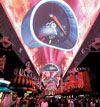
No bulb is as small as an LED. That advantage opens up innumerable potential uses and freedom in design. Smaller than a pinhead or a ladybird, LEDs can be varied in arrangement to provide a custom lighting layout. Their compact dimensions mean lighting solutions can now be realised which were previously extremely difficult or even impossible, such as illuminating the edge of a step or a stairway handrail. In such applications it is not only the small size of LEDs which is key, but also the fact that they do not emit heat in the direction of their light radiation. This makes it possible to build LEDs into carpets for example, either as a visual highlight or to mark an escape route.
The fact that there is no IR or UV component in LED light is even revolutionising lighting in museums, because UV radiation causes the colours of paintings to fade, leading to irrecoverable loss. After a visitor threw a stone at what is probably the most famous of all art works - the Mona Lisa - in 1956, the authorities at the Louvre placed the picture behind glass in order to fend off further attacks. Unfortunately this resulted in frustration for visitors, as the famously mysterious face was distorted by the dull lighting, which also caused reflection from the glass covering.
In response to such problems, the Fraen Corporation in Italy devised a special form of LED lighting providing a light equivalent to daylight, yet with no IR or UV component.
A defined direction of emission was also fixed, in order to eliminate the reflections. Now the glass and the LED lighting are providing the Mona Lisa with twin protection - against vandalism and against fading. So her smile will continue to provide a source of charm and mystery for generations to come.
At any angle
In order to achieve special effects with lighting or accentuate certain features, LEDs enable the angle of radiation to be altered. LEDs have a plastic cap on their package to protect the semiconductor crystal. It usually also serves as a lens - termed the primary lens. The wired chip is recessed in the package deeper or higher depending on the angle of radiation required. The distance between the chip and the lens, and the curvature of the lens, results in different angles. The principle is similar to that of a magnifying glass.
To widen or narrow the angle of radiation of specific LED types, there are optics (secondary optics) mounted in front of the LED. They allow the LED light to be bundled.
The result is a tightly restricted light, which is particularly well suited to spotlighting. As the angle of radiation increases, the light intensity decreases but the overall light output remains the same. As well as this closely targeted and simple light control - which in contrast to other forms of lamp can be achieved without complex and costly installation of various reflectors - LEDs also offer an innovation in lighting technology: adjustable light colour.
Interplay in a sea of colours
Coloured light can be generated effectively and directly - that is, without colour filters. And the colour saturation is particularly high. Because all the possible tones can be mixed together, the use of LEDs is cost-effective where objects are intended to appear repeatedly in different colours. This is frequently the case in department store display windows. If they display products from different suppliers each week, for example, the lighting must be adapted to the corporate identity (CI) of the respective supplier. It would be hugely expensive to change all the lights. LED lighting offers the facility to adapt the colour and intensity settings at the click of a button on a computer.
That colour change facility can be demonstrated in even more spectacular style too. As the colours change within a few milliseconds, LEDs can be combined as required to construct a giant screen. An example of this method is in Las Vegas - the city that never sleeps. The main attraction on Fremont Street is Viva Vision, an overhead screen just under 28 metres wide and almost half a kilometre long, forming a canopy spanning the old town.

With 12,5 million LED modules capable of displaying 16,7 million colour combinations and a 550 000 W sound system, the world's largest screen is used not just for advertising, but also presents amazing light and sound shows to attract visitors away from the newer area of town along the Strip. This LED application will doubtless remain a crowd-pulling spectacle for a long time to come.
Overview of LED optics
The most common primary optics include the Lambert lamp, which offers a constant light density in all directions. The Batwing lens generates a symmetrical profile around the optical axis, with the highest light intensity at about 20° to 40° from the axis. The side emitter lens emits its light perpendicular to the optical axis. Reflectors or combinations of various optical elements are termed secondary optics. A simple reflector generates a strong central beam of light around which a diffuse light cone forms. The principle of the TIR (total internal reflection) optic is the most frequently used secondary optic for high-power LEDs.
| Tel: | +27 11 236 1900 |
| Email: | [email protected] |
| www: | www.ebv.com |
| Articles: | More information and articles about EBV Electrolink |

© Technews Publishing (Pty) Ltd | All Rights Reserved